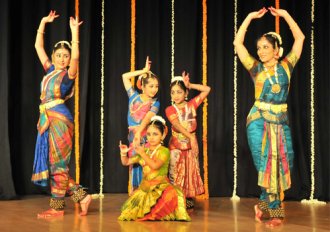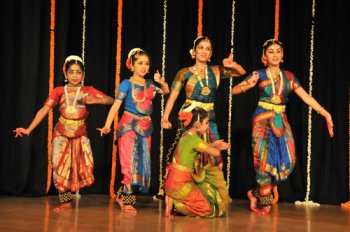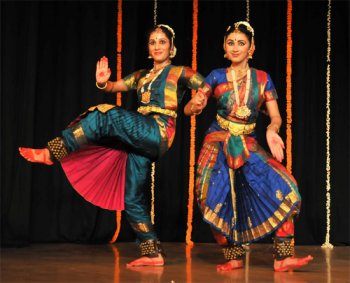
|   |

|   |
Not one to disappoint - Jyothi Raghuram, Bangalore e-mail: jyothi.r.ram@gmail.com November 28, 2012 When Guru Padmini Ramachandran’s Natyapriya presented ‘Nrityarpana’ at the Purandara Bhavana recently, two thoughts crossed one’s mind - rarely has one been disappointed by a dance recital of Natyapriya, and the wards, even if their age is yet to reach double digits, are groomed to perform on stage in a professional manner right from an early stage.  Nrityarpana showcased some of the little dancers of Natyapriya, the youngest among them being Advaitha Jayakumar. At seven, she presented her numbers in all seriousness, be it the dasa pada, “Krishna Baaro” that was tagged to a Tamil folk song, “Maadu meikkum kanne” or the well known Dikshitar kriti, “Kanchadalayatakshi” (Kamalamanohari). Ruhika Joshi and Ashwitha Krishnan, at nine, were the other two dancers just that much senior to Advaitha. For all three, it was their first solo outing. They did not falter at any time. Nor did they have to be prompted from the wings, which itself gave their presentation a professional touch, considering their age.  In all honesty, such young children dancing on stage are usually mere caricatures, endearing only to the parents. Natyapriya’s dancers were an exception. Each item was carefully chosen, crafted, and tailored to suit the age of the dancer. Variety marked the show. The dancers were well-groomed including on stage conduct, although with Ruhika, the form has still to set in fully.  It is not easy to dance to Guru Padmini’s tunes! She is one teacher who is exacting. She also does not cheat the audience by reciting the shollakattus at breakneck speed, while her dancer’s footwork moves at a slower pace, a trick which gives the audience an impression of speedy nritta. Although dealing with little dancers, even in the descriptive pieces, it was not merely the literal meaning that was projected. Guru Padmini’s jathis are not easy to deal with either, their complex yet beautiful tapestry, and the variations in laya demanding much more than ordinary practice from a dancer. The old favourite “Nee inda maayam,” the Dhanyasi varnam, saw Ruhika doing justice to her teacher’s efforts. Ashwitha stood up to the robustness of the composition in “Shankara Sri Giri” (Hamsanandi). An evergreen Mohammad Rafi song, “Madhuban mein”, was presented in classical mould by Ruhika, reflecting again Guru Padmini’s innovative style and thinking. Nrityarpana was also an occasion for a senior ward of Natyapriya, Sharmila, and her daughter Aradhana, to dance together on stage, for the first time. They presented “Gajavadana Beduve” (Hamsadwani), and a misra alaripu, besides solos - Aradhana in a padam, “Idathu paadam thooki” (Khamas) and Sharmila in “Adadu asangadu vaa” (Madhyamavathi). While Sharmila had the comfortable air of an experienced performer, Aradhana struck a discordant note in the show. Her shoddy hastakshetras and non-existent footwork showed that she is yet to grasp the basics. The musical support was a mixed bag. Guru Padmini’s nattuvangam was full of life. Vocalist Balasubramanya Sharma did not contribute to the melody. Violinist Dr. Nataraja Murthy was a steady presence, aided by mridangist Janardhan and flautist Narasimha Murthy. The bright costumes (Arumugam) were neat; make-up by Raghunath, and the jewellery, suited the age of the dancers. Jyothi Raghuram is a journalist with over two decades experience in both the print and electronic media, having worked with news organizations such as PTI, The Hindu and Indian Express. Her specialized writings on the performing and visual arts have been considered as benchmarks for their comprehensive and in-depth dealing of the subjects. |